I have a plot based on my data nd with three geom_line() that demonstrates the probability of death after 1-yr: nd$y_et, 3-yrs: nd$y_tre and 5-yrs: nd$y_fem, respectively, as function of number of resected lymph nodes nd$n_fjernet.
Question: how can I fill each area below the three individual geom_line() of nd$y_et, y_tre, y_fem, without the fill overlapping the subsequent geom_line + fill?
I tried geom_area and geom_polygon but did not come even close to a proper solution.
Current plot
With
ggplot(nd, aes(x=n_fjernet)) +
geom_line(aes(y=y_et)) +
geom_line(aes(y=y_tre)) +
geom_line(aes(y=y_fem)) + scale_x_continuous(breaks = seq(0,25,5), limits=c(0,25))
Should give the expected output:
UPDATE
I applied the solution provided below, yielding
ndd %>%
rename(X3=y_et, X2=y_tre, X1=y_fem) %>%
pivot_longer(values_to="N", names_to="Variable", cols=c(X1:X3)) %>%
ggplot(aes(x=n_fjernet, y=N, fill=Variable, colour=Variable)) +
geom_area(position=position_identity(), alpha=.15) +
geom_line(size=3, color="white") +
geom_line(size=.75) +
scale_fill_manual(values=c("#2C77BF", "#E38072", "#6DBCC3")) +
scale_colour_manual(values=c("#2C77BF", "#E38072", "#6DBCC3")) +
scale_x_continuous(breaks = seq(0,10,5), limits=c(0,10))
With
As we are getting close to the intended plot, there unfortunately still overlapping fills. The blue-fill can be seen behind the red-fill; and, both the blue-fill and red-fill is behind the green-fill.
Question: how to include the fills without overlapping?
My data nd
nd <- structure(list(y_et = c(0.473, 0.473, 0.472, 0.471, 0.471, 0.47,
0.47, 0.469, 0.468, 0.468, 0.467, 0.467, 0.466, 0.465, 0.465,
0.464, 0.464, 0.463, 0.462, 0.462, 0.461, 0.461, 0.46, 0.459,
0.459, 0.458, 0.458, 0.457, 0.456, 0.456, 0.455, 0.455, 0.454,
0.453, 0.453, 0.452, 0.452, 0.451, 0.45, 0.45, 0.449, 0.449,
0.448, 0.447, 0.447, 0.446, 0.446, 0.445, 0.445, 0.444, 0.443,
0.443, 0.442, 0.442, 0.441, 0.44, 0.44, 0.439, 0.439, 0.438,
0.438, 0.437, 0.436, 0.436, 0.435, 0.435, 0.434, 0.433, 0.433,
0.432, 0.432, 0.431, 0.431, 0.43, 0.429, 0.429, 0.428, 0.428,
0.427, 0.427, 0.426, 0.425, 0.425, 0.424, 0.424, 0.423, 0.423,
0.422, 0.421, 0.421, 0.42, 0.42, 0.419, 0.419, 0.418, 0.417,
0.417, 0.416, 0.416, 0.415), y_tre = c(0.895, 0.894, 0.894, 0.893,
0.893, 0.893, 0.892, 0.892, 0.891, 0.891, 0.89, 0.89, 0.889,
0.889, 0.889, 0.888, 0.888, 0.887, 0.887, 0.886, 0.886, 0.886,
0.885, 0.885, 0.884, 0.884, 0.883, 0.883, 0.882, 0.882, 0.881,
0.881, 0.881, 0.88, 0.88, 0.879, 0.879, 0.878, 0.878, 0.877,
0.877, 0.876, 0.876, 0.875, 0.875, 0.875, 0.874, 0.874, 0.873,
0.873, 0.872, 0.872, 0.871, 0.871, 0.87, 0.87, 0.869, 0.869,
0.868, 0.868, 0.867, 0.867, 0.866, 0.866, 0.865, 0.865, 0.865,
0.864, 0.864, 0.863, 0.863, 0.862, 0.862, 0.861, 0.861, 0.86,
0.86, 0.859, 0.859, 0.858, 0.858, 0.857, 0.857, 0.856, 0.856,
0.855, 0.855, 0.854, 0.854, 0.853, 0.853, 0.852, 0.852, 0.851,
0.851, 0.85, 0.85, 0.849, 0.848, 0.848), y_fem = c(0.974, 0.974,
0.973, 0.973, 0.973, 0.973, 0.973, 0.973, 0.972, 0.972, 0.972,
0.972, 0.972, 0.971, 0.971, 0.971, 0.971, 0.971, 0.971, 0.97,
0.97, 0.97, 0.97, 0.97, 0.969, 0.969, 0.969, 0.969, 0.969, 0.968,
0.968, 0.968, 0.968, 0.968, 0.967, 0.967, 0.967, 0.967, 0.967,
0.966, 0.966, 0.966, 0.966, 0.966, 0.965, 0.965, 0.965, 0.965,
0.965, 0.964, 0.964, 0.964, 0.964, 0.963, 0.963, 0.963, 0.963,
0.963, 0.962, 0.962, 0.962, 0.962, 0.961, 0.961, 0.961, 0.961,
0.961, 0.96, 0.96, 0.96, 0.96, 0.959, 0.959, 0.959, 0.959, 0.958,
0.958, 0.958, 0.958, 0.957, 0.957, 0.957, 0.957, 0.957, 0.956,
0.956, 0.956, 0.956, 0.955, 0.955, 0.955, 0.955, 0.954, 0.954,
0.954, 0.954, 0.953, 0.953, 0.953, 0.952), n_fjernet = c(0, 0.1,
0.2, 0.3, 0.4, 0.5, 0.6, 0.7, 0.8, 0.9, 1, 1.1, 1.2, 1.3, 1.4,
1.5, 1.6, 1.7, 1.8, 1.9, 2, 2.1, 2.2, 2.3, 2.4, 2.5, 2.6, 2.7,
2.8, 2.9, 3, 3.1, 3.2, 3.3, 3.4, 3.5, 3.6, 3.7, 3.8, 3.9, 4,
4.1, 4.2, 4.3, 4.4, 4.5, 4.6, 4.7, 4.8, 4.9, 5, 5.1, 5.2, 5.3,
5.4, 5.5, 5.6, 5.7, 5.8, 5.9, 6, 6.1, 6.2, 6.3, 6.4, 6.5, 6.6,
6.7, 6.8, 6.9, 7, 7.1, 7.2, 7.3, 7.4, 7.5, 7.6, 7.7, 7.8, 7.9,
8, 8.1, 8.2, 8.3, 8.4, 8.5, 8.6, 8.7, 8.8, 8.9, 9, 9.1, 9.2,
9.3, 9.4, 9.5, 9.6, 9.7, 9.8, 9.9)), row.names = c(NA, -100L), class = c("data.table",
"data.frame"))







